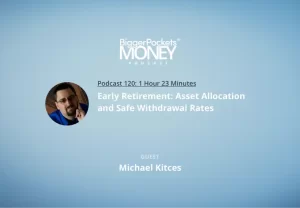Special to Financial Independence Hub
I’m not a huge listener to podcasts but I do enjoy them from time to time …
A few years back, I listened to a BiggerPockets Podcast with financial independence enthusiast, U.S. financial planner, commentator and educator Michael Kitces as a guest.
This podcast delved into the 4% safe withdrawal rate that so many, many, many….DIY investors in the early retirement community rely on and why Michael Kitces ultimately believes the 4% rule actually remains a very good rule of thumb to plan by – to a point.
If you don’t have an hour and 22 minutes to listen to this episode (not many people do…) then no worries, I’ve captured the essence of the interview below.
In this updated post (with some new links), I share my own thinking on this subject and why I won’t use the 4% rule myself for any detailed planning work for us.
Could the 4% rule remain a decent rule of thumb?
In general terms, the “4% rule” says that you can withdraw “safely” 4% of your savings each year (and increase it every year by the rate of inflation) from the time you retire and have a very high probability you’ll never run out of money.
Some things to keep in mind when you read this:
- This ‘rule’ originated from a paper written in the mid-1990s by a financial planner in the U.S. who looked at rolling 30-year periods of a 50% equity/50% fixed income asset allocation. His name was Bill Bengen.
2. This rule was developed almost 30 years ago. A lot has changed since then including real returns from bonds. There are also products on the market now that allow investors to diversify far beyond the mix of large-cap U.S. stocks and treasuries the Bengen study was based on.
3. The study was designed to answer the question: “How much can I safely withdraw from my retirement savings each year and have my nest egg last for the duration of my retirement?” Little else.
4. The study assumed (at the time) most retirees would retire around age 60. Therefore, a “good retirement” would be ~30 years thereafter; what is the safe withdrawal rate to make it through retirement until death.
5. The rule takes none of the following into account:
- Will you (or your spouse) have a defined benefit pension plan?
- Do you expect to receive an inheritance?
- Will you downsize your home?
- Do you have a shortened life expectancy or health issues that should be considered?
- Will you continue to earn some form of income in your senior years?
- And the list of what ifs goes on and on and on …
My 4% rule example
My wife and I aspire to have a paid off condo AND own > $1M personal portfolio to start semi-retirement with. We hope those days are near. We’ve always considered the 4% rule a decent starting point for our portfolio drawdown ideas but that’s where it ends for us.
Using that desired investment value, if we can grow our portfolio to over $1M, the 4% rule tells us we could expect to withdraw about 4% of that million-dollar nest egg ($40,000 per year indexed to inflation) and have virtually no concerns we would run out of money for the next 30 years (early 80s).
But just living off dividends or distributions (which is about 4% of our portfolio yield) doesn’t make much sense in perpetuity. I’ll come back to that point in a bit.
To the podcast and some takeaways!
On the subject of a 4% withdrawal rate – is that conservative?
Michael: Yes. If your time horizon is 30-years, it probably is. Because, when Bengen looked at his different rolling periods … he found the worst case scenario was a withdrawal rate of about 4.15%. “It was the one rate that worked in the worst historical market sequence…”.
Does recent data say anything different since the 1994 study?
Michael: Not really. Michael and his team replicated the Bengen study and generally arrived at the same number. And that’s not the only good news … 50% of the time using the 4% rule you will as Michael puts it “double your wealth.”
So, 50% of the time (market returns willing) you will finish with almost X3 wealth on top of a lifetime of spending using the 4% rule.
“…the reality remains that by withdrawing at “only” a 4% initial withdrawal rate, the overwhelming majority of the time retirees just finish with a massive excess amount of assets left over!”
Check out the outstanding Michael Kitces study on the 4% withdrawal rule – that shows the extraordinary upside potential in sequence of return risk.
From that post:
“…taking even “just” a 5% initial withdrawal rate (and adjusting spending for inflation in each subsequent year) actually runs out of money in nearly 25% of historical scenarios… even though a higher 5.4% withdrawal rate “worked” when projecting the lowest 30-year average returns in history!”
What if you retire at the worst possible time? Example, on the eve of the 2008-2009 financial crisis?
Michael: Doesn’t matter. 4% worked. Thanks to a massive bull run for the 10 years that followed, as bad as the 2008-2009 financial crisis was, you were still trending far ahead.
What about FIRE (Financial Independence, Retire Early)? What if your time horizon was say 40-years or more?
Michael: You’ll need to go down to 3.5% rule. Why? The longer your retirement time horizon, the more you’ll need to pull down your “safe” withdrawal rate. But, it’s not as much as you might think even if you’re talking 40, 50, or 60-year retirement periods.
Is 3.5% a super safe withdrawal rate?
Michael: Yes, but he wouldn’t advise it. From a purist perspective, 3.5% withdrawals will work if you literally never make an adjustment. You could have retired on the eve of The Great Depression, coming out of the date withdrawing 3.5% and gone for 50 years, and you still had money left over at the end. Sure, there is always a risk that the future could be worse (series of market returns) than the investing past but nothing is a guarantee. The 4% rule is just ratcheting down to the worse case scenarios to be our baseline.
On the subject of a cash wedge …
Michael: Lots of cash hurts more than it helps. Why? The hard math answer is at the end of the day, it hurts more than it helps. This is why you have bonds in your portfolio. Cash doesn’t provide the yield or upside that bonds do in a bear market. Mind you, if you can get 2%+ interest on your cash, well, that’s largely a wash these days.
Here is more on the cash wedge approach.
On the subject of a FIRE (Financial Independence, Retire Early) movement …
Michael: Kitces believes as I do that the “RE” part of FIRE is rather sensational. Again, nobody in their 30s or 40s really “retires” and does nothing for income for decades on end. Most just spend their time working on something, for income, and good for them. Don’t believe all the hype. He cited when he sees clients in practice, when they actually retire, he sees depression increase, isolationism increase, divorce rates increase. There’s actually “all sorts of bad stuff that happen after retirement.” The reason? You need a reason to get up in the morning and be productive. Michael would argue that’s just how humans are wired. Don’t fight it.
Overall, I enjoyed the podcast with Michael Kitces and the discussions related to the 4% safe withdrawal rate.
Kitces’ position on the 4% rule, on financial independence over retire early, always keeping some cash but not too much, and constantly being willing to adjust your plans aligns to my DIY investing and thinking.
As we consider part-time work, our plan is largely the following:
1. Live off dividends and distributions from the taxable accounts, for a few years, as we work part-time:

2. Make slow, methodical RRSP withdrawals during our 50s, 60s and 70s and spend all capital.
3. Allow TFSA assets to compound away, over the coming decades in Canadian stocks and low-cost ETFs to enjoy tax-free dividend and distribution income as we age.
In reality, instead of following of the 4% rule let alone living off any dividends or distributions in perpetuity, we’ll likely use some sort of Variable Percentage Withdrawal (VPW) strategy. Probably most investors should do the same.
VPW = spend more money in good times and cut back some spending during bad market times.
Check out this post on that subject here – the benefits of variable percentage withdrawal.
For further reading on the 4% rule including other articles on my site, check these ones below. Using the 4% rule for your retirement plan might make no sense at all AND there are ways to retire early ignoring this rule altogether. 🙂
Let me know your thoughts on this subject.
Mark
 Mark Seed is a passionate DIY investor who lives in Ottawa. He invests in Canadian and U.S. dividend paying stocks and low-cost Exchange Traded Funds on his quest to own a $1 million portfolio for an early retirement. You can follow Mark’s insights and perspectives on investing, and much more, by visiting My Own Advisor. This blog originally appeared on his site on May 29, 2023 and is republished on the Hub with his permission.
Mark Seed is a passionate DIY investor who lives in Ottawa. He invests in Canadian and U.S. dividend paying stocks and low-cost Exchange Traded Funds on his quest to own a $1 million portfolio for an early retirement. You can follow Mark’s insights and perspectives on investing, and much more, by visiting My Own Advisor. This blog originally appeared on his site on May 29, 2023 and is republished on the Hub with his permission.





Mark, there are so many deficiencies with the 4% rule that it has resulted in experts advising that retirees reduce withdrawals to less than 4%, often resulting in people not spending enough and dying with too much money. Please take a look at this summary paper that analyses various strategies and discusses the benefits of a modified RMD strategy. I believe this could be an effective strategy that allows retirees to spend more without the risk of running out of money. https://crr.bc.edu/wp-content/uploads/2012/10/IB_12-19-508.pdf